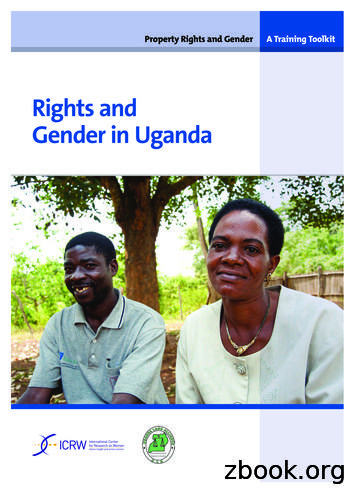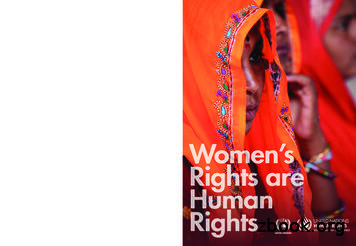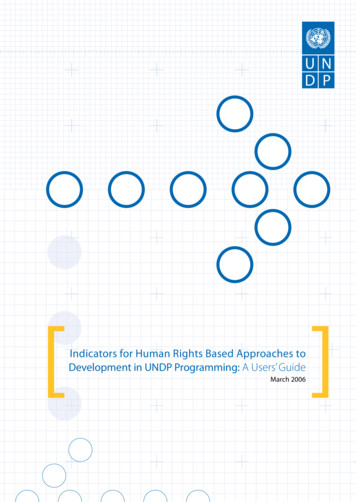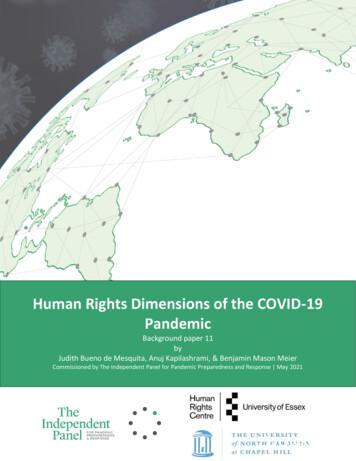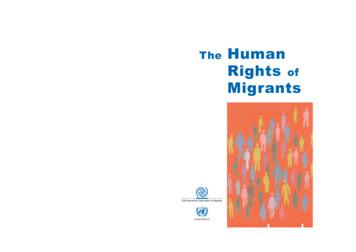Understanding Human Rights
Photo: ShutterstockHuman rightseducation resourcesfor teachersUnderstandinghuman rights
rightsED Understanding human rightsUnderstanding human rightsSubjects:Civics and Citizenship, History, Geography,Legal Studies, International StudiesLevel:Year 9 and up (14 years and up)Time needed: 1–4 lessonsHuman rightseducation resourcesfor teachersIntroductionHuman rights are basic to humanity. They apply to all people everywhere. An understanding of humanrights is an important part of our individual status as human beings and of our collective status asmembers of the global community of humankind.To understand how human rights affect us in our daily lives and to acknowledge our responsibilities inrecognising the need to balance those rights with the rights of others, we require an understanding ofwhat human rights are.So what are human rights? Where did they come from? How do they impact on humanity? How dothey affect me?AimUnderstanding human rights includes activities that are designed to help students clarify humanrights concepts and provide an opportunity to explore the effect of human rights in their own lives.They can be photocopied for class use and used individually or as an entire resource.The resources provide students with: basic information about the concepts encompassed by the term ‘human rights’ an historical context for the development of human rights laws and the establishment of theUnited Nations the processes involved in the drafting and publication of international documents and treaties thatsupport human rights an overview of how human rights are incorporated at a national level in Australia an understanding of how human rights are relevant in every day life.Learning outcomesIn this topic students will: develop an understanding of what human rights are understand the origins of modern human rights appreciate the meaning and significance of the Universal Declaration of Human Rights and otherhuman rights instruments appreciate the relationship between rights and responsibilities understand the forms human rights can take, legally and morally understand how human rights instruments are applied in Australian law and society analyse the relationship of human rights to daily life apply the concepts of human rights to their own lives.2 Australian Human Rights Commission 2010 www.humanrights.gov.au/education/understanding human rights
rightsED Understanding human rightsActivities/resources1. What are human rights? Resource sheet: What are human rights? Key questions: Human rights Activity sheet: What are human rights?2. The origins of modern human rights laws Resource sheet: The origins of modern human rights law Key questions: The origins of human rights Activity sheet: The origins of modern human rights law3. The Universal Declaration of Human Rights and other human rights instruments Resource sheet: The Universal Declaration of Human Rights and other human rights instruments Key questions: Universal Declaration of Human Rights Activity sheet: Identifying human rights4. Human rights in Australia Resource sheet: Human rights in AustraliaKey questions: Human rights in AustraliaActivity sheet: Australian perspectivesKey questions: My community Australian Human Rights Commission 2010 www.humanrights.gov.au/education/understanding human rights3
Teaching strategiesrightsED Understanding human rightsTeaching strategies1. What are human rights? Resource sheet: What are human rights? Key questions: Human rights Activity sheet: What are human rights?This stage introduces some of the important terminology used to discuss human rights. It also explainsthe concept of human rights in a way that will set the context for the ideas explored in the later stagesof the unit.The activity associated with this stage helps establish the level of knowledge students already haveabout human rights. Of course, it is likely that the term is not completely new to many of them;however, the depth and accuracy of each student’s understanding may vary widely. It may beinteresting to compare the difference in students’ levels of understanding by looking at their responsesto the activity both before and after the delivery of the unit. This activity may be most effectivelycompleted individually, rather than as group work, so that students can see their own levels ofknowledge and understanding in the first instance.In addressing the key questions put forward at the end of this unit, students should be encouraged toidentify the relevant issues.Some of the issues raised may include: Who has responsibility for acknowledging human rights? governments (get students to think about how this might work in a totalitarian state) organisations, such as the United Nations, Amnesty International, the International Committeeof the Red Cross, etc. communities, such as school communities, town communities, club communities, etc individuals, such as you and I. What are some terms that describe what human rights are concerned with? dignity, respect responsibility values systems moral and legal rights justice, tolerance, equality interaction between people and their community. Where do human rights come from? philosophies put forward by thinkers of the ancient world (e.g., Plato, Marcus Aurelius, Cicero,St. Augustine) religious principles from a range of world religions philosophical positions from thinkers of the Renaissance and the Enlightenment periods (e.g.,Locke, Bacon, Descartes, Voltaire) political struggles, such as the French Revolution, the American Civil War, women’s suffrage,collapse of apartheid system in South Africa. Do you think human rights are important? Why? unique value of each person and their common humanity the importance of recognising every individual’s dignity4 Australian Human Rights Commission 2010 www.humanrights.gov.au/education/understanding human rights
rightsED Understanding human rights the need for freedom of thought, movement, ideas the need to operate as part of a community the value of mutual respect between people a system of values by which individuals and communities can interact together constructively need for balance between rights, our duty to acknowledge and respecting rights of others.2. The origins of modern human rights laws Resource sheet: The origins of modern human rights law Key questions: The origins of human rights Activity sheet: The origins of modern human rights lawsThis stage places the concept of ‘human rights’ within a specific historical context. It looks at the roleof World War II in focusing the will of nations to establish a universal system to define, protect andpromote human rights. By thinking about the human rights abuses that occurred during World War II,students will more fully appreciate the importance of the decision taken by the international communityto establish the United Nations.This stage provides the opportunity for the class to discuss what they know about World War II,drawing on history studies they have already undertaken; films or television programs about World WarII that students have seen; books they have read; or even stories of the War that they have heard fromelderly friends or relatives.Such a discussion, in conjunction with working through the information provided, will keep the focuson the serious human rights violations that occurred during World War II. The Activity sheet: Origins ofmodern human rights is suitable for use either in pairs or small groups.The key questions are designed to clarify students’ understanding of the main issues. In the case of thefirst question, it may be useful to draw a timeline with some significant dates on it to prompt studentsto think how human rights are related to historical events.The question ‘How and when was the United Nations formed?’ gives students an opportunity toexplore the extent of the human rights abuses perpetrated in a time of war and the internationalreaction to those abuses.In answering the question think about what aspects of some of the wars that took place beforeWorld War II had an influence on the development of human rights. Students may think aboutissues such as: rebellion to combat monarchic oppression, e.g. the French Revolution rebellion to combat foreign power, e.g. the Boxer Rebellion development of statements about rights in the aftermath of war or revolution (e.g. the MagnaCarta (UK), the Declaration of the Rights of Man (France)).Issues to consider when responding to the question – what issues of human rights abuses in WWIImay have prompted the formation of the United Nations, could include: discrimination against particular groups of people (e.g. Jews, people with disabilities,homosexuals, communists etc.) torture, cruel and inhuman treatment (e.g. starvation, subjection to ‘experiments’, rapes, beatingsetc.) genocide (e.g. the systematic destruction of races of people) contravention of the Geneva Convention of 1929 regarding treatment of prisoners of war. Australian Human Rights Commission 2010 www.humanrights.gov.au/education/understanding human rights5
rightsED Understanding human rights3. The Universal Declaration of Human Rights and other human rights instruments Resource sheet: The Universal Declaration of Human Rights and other human rights instruments Key questions: Universal Declaration of Human Rights Activity sheet: Identifying human rightsThis activity is another group learning exercise, focusing on the development of the documents andtreaties that support human rights and inform national and international human rights law. It may beuseful to look at the full transcript of the Universal Declaration of Human Rights (available from thewebsite of the United Nations Office of the High Commissioner for Human Rights athttp://www.unhchr.ch/udhr/lang/eng.htm).At this point, other resources may also be useful by way of comparison between human rights andother ‘types’ of rights. Through exposure to dramatised representations in film and television, somestudents may have a concept of ‘rights’ having to do with what happens when you have a ‘run in withthe law’. Phrases like ‘Did you read him his rights?’ or ‘He took the fifth amendment’ are a product ofAmerican media and, of course, refer specifically to the American legal system. Some clarification ofthese points may be necessary for students, depending on how and when you present this unit and inwhat cross-curricular context.The Activity sheet: Identifying human rights may be completed individually, in pairs, in small groupsor as a whole class. It provides an opportunity for students to demonstrate their understanding ofthe difference between human rights and other issues that might have rights implications but are not‘human rights’ as such. It is an important distinction that differentiates the inherent moral power ofhuman rights and the legal and social implications of other sorts of rights, entitlements and assertions.The key questions seek to ensure students have acquired an understanding of the instruments ofhuman rights.In discussing the key questions, points that students may find useful in clarifying the terms mightinclude: the Universal Declaration of Human Rights (UDHR) is an internationally agreed statement thatacknowledges the inherent dignity of each person the UDHR is a series of ‘articles’ that defines universal human rights the UDHR is recognised as a statement of powerful moral force and is often quoted in defence ofthose for whom human rights organisations may advocate (e.g., political prisoners) the acknowledgments made in the UDHR are useful for individuals to apply to their definitions ofhow to show respect for others’ humanity treaties are agreements between different countries treaties are solemn agreements, entered into with an understanding that they are binding.Note that further activities around the UDHR are available as part of the Commemorating HumanRights Day activities/resources. For more detailed background information on human rights laws, referto Human Rights Explained fact sheets, and the Let’s talk about rights Consultation Toolkit.4: Human rights in Australia Resource sheet: Human rights in Australia Key questions: Human rights in Australia Activity sheet: Australian perspectives Key questions: My communityThis activity looks at how human rights, which have been incorporated into international law, aretranslated in the Australian context.6 Australian Human Rights Commission 2010 www.humanrights.gov.au/education/understanding human rights
rightsED Understanding human rightsIt would be pertinent in working through the information in this unit to consider some of the humanrights issues in Australia that have attracted international attention and drawn comment from theUN. To read about these issues visit the UN News (web link at http://www.un.org/News/ ) and doan advanced search for ‘Australia’. Alternatively, you could check the latest Human Rights CouncilPeriodic Report on Australia.The activities give the opportunity to use teaching strategies such as: structured debate, role-playsand dramatisation of the issues. Teachers could provide a range of newspapers and magazines or askstudents to bring some in; or you could direct them to watch particular current affairs programs.Narrowing the focus from the international setting to the Australian community, the key questionsencourage students to enquire into the human rights conditions in their own environment. Whilestudents explore various answers, it may be useful to mention race discrimination law, sexdiscrimination law, age discrimination law and disability discrimination law in Australia. Informationregarding these laws is provided on the Commission’s website at www.humanrights.gov.au.Identification of issues currently in focus will depend on the types of human rights issues being coveredin the media at the time that you are presenting this topic. How the students feel about issues that areraised is an important aspect in allowing students to engage personally with the concepts that havebeen dealt with.Some issues that may evoke a response from students could include: treatment of people in Australia’s immigration detention centres treatment of Arab Australians and Muslim Australians reconciliation between Indigenous and non-Indigenous Australians paid maternity leave, and other issues facing women in the workplace any cases of discrimination on the basis of sex, race, age or disability that may be current.The key questions posed could focus on scenarios such as students’ responses to: witnessing of physical abuse or verbal harassment of someone because of clothing they maywear in religious observance behaviour that is unreasonable and disrespectful to people because of some single characteristic(e.g. road rage against people from a particular racial groups) sexual harassment where someone is being ‘hassled’ for how they look or the clothes they wear.It would be useful to clarify students’ level of understanding by asking them to discuss in each casewhich human rights they think are being infringed.Some of the sorts of ideas students may like to think about in terms of promoting human rights couldinclude: actively attempting to show respect to all the people they deal with day to day with others where they see human rights abuses occurring joining organisations that promote human rights (such as Amnesty International, or any of a rangeof charitable humanitarian organisations) developing fundraising drives at the school to donate money to human rights organisations.Note that the human rights consultations in 2009 have raised some interesting questions abouthuman rights protection in Australia. For further details on the limitations of human rights protectionsin Australia, as well as the submissions made to the consultation process, refer to the Let’s talk aboutrights resources. Australian Human Rights Commission 2010 www.humanrights.gov.au/education/understanding human rights7
rightsED Understanding human rightsResource sheetWhat are human rights?The basic notion of human rights lies in people’s recognition of the need to protect andaffirm every other person’s individual dignity. Human rights are important. No matterwhere people come from, or what their age, culture, religion or income may be, they tendto talk about their concerns in terms of human rights. Human rights issues are often seenas national or international in scope, but human rights are equally relevant at an individualand community level.So what are human rights?There is no universally agreed definition; indeed, people’s understanding of human rights is continuallyevolving. There are general understandings, though, of what is meant by the term. One way of lookingat rights is to see them as a special kind of claim on others. For example, the right to education meansthat everyone is entitled to a good education and, in particular, that governments have an obligation toprovide education facilities and services.Rights are related to the values that societies live by. These values have their origins in the world’s greatreligions and philosophies. Value systems can vary in detail between one society and another but thefundamental ideas are very similar. Concepts of justice and human dignity are at the heart of thesevalues.Rights also relate to what is lawful: that is, some rights may be laid down in law. If you have a legal rightto something, you may be able to defend it in court. In many situations, though, rights exist but are notcovered by law. These rights are often called moral rights. Moral rights are based on people’s sense ofwhat is fair or just.Which rights?There can be differing views on human rights – for example about which rights are more important orwhether a particular moral or legal right is a human right. When we talk about human rights we areusually referring to those principles that the nations of the world have agreed to refer to as humanrights. These have been set down in international agreements and form part of international law. Therights set out in these agreements are often also written into the domestic law of individual countries.Human rights cover virtually every area of human activity. They include civil and political rights, suchas freedom of speech and freedom from torture. They also include economic and social rights, suchas the rights to health and education. Some rights apply to individuals, such as the right to a fair trial:these are called individual rights. Others apply to groups of people, such as the right to a healthyenvironment or to native title: these are called collective rights.Human rights and responsibilitiesHuman rights involve responsibility and duties toward other people and the community. Individualsoften have a responsibility to ensure that they exercise their rights with due regard for the rights ofothers. For example, exercising freedom of speech should not infringe someone else’s right to privacy.Human rights are part of a context of people living together in societies. As part of this, there must be alegal, social and international order for human rights to be realised effectively.For more information refer to the Human Rights Explained fact sheets athttp://www.humanrights.gov.au/education/hr explained/index.html8 Australian Human Rights Commission 2010 www.humanrights.gov.au/education/understanding human rights
rightsED Understanding human rightsKey questionsHuman rights1. Who has the responsibility to respect and protect human rights?.2. What are some terms that describe what human rights are concerned with?.3. Where do human rights come from?.4. Do you think human rights are important? Why?.5. Which rights are most important? Why?. Australian Human Rights Commission 2010 www.humanrights.gov.au/education/understanding human rights9
rightsED Understanding human rightsActivity sheetWhat are human rights?The following activity explores what you currently know about human rights.Look at each of the statements below. Place a tick in the appropriate box to indicatewhether you think the statement is true, false, or if you aren’t sure.StatementTrueFalseNot sure1. There are rights which every person has and whichcannot be taken away from them2. There are responsibilities which go with every right3. The individual is the most important unit in society andhas to come first4. The group is the most important unit in society and hasto come first5. Rights must ultimately be consistent with religiousprinciples6. People have basic economic rights7. People have basic obligations towards the environment8. Within a society there may be special Indigenouspeople’s rights9. Basic rights can never be taken away10. All people have equal rightsMake some notes here about any of the statements where you answered ‘not sure’. Would you needto change the wording of any of the statements to make them easier to identify as ‘true’ or ‘false’?.10 Australian Human Rights Commission 2010 www.humanrights.gov.au/education/understanding human rights
rightsED Understanding human rightsResource sheetThe origins of modern human rights lawsThroughout history, concepts of ethical behaviour, justice and human dignity have been important inthe development of human societies, as has the question of the relationship of the individual to thewider community. Such ideas can be traced back to the ancient civilisations of Babylon, China andIndia. They contributed to the laws of Greek and Roman society and are central to Buddhist, Christian,Confucian, Hindu, Islamic and Jewish teachings. Concepts of ethics, justice and dignity were alsoimportant in societies which have not left written records, but consist of oral histories such as those ofIndigenous people in Australia and elsewhere.Ideas about justice were prominent in the thinking of philosophers in the Middle Ages, the Renaissanceand the Enlightenment. An important strand in this thinking was that there was a ‘natural law’ thatstood above the law of rulers. This meant that individuals had certain rights simply because they werehuman beings. Significant development in thinking about human rights took place in the seventeenthand eighteenth centuries. This found expression in the American Declaration of Independence (1776)and the French Declaration of the Rights of Man and the Citizen (1789). Whereas earlier the focus hadbeen on the sovereignty of rulers, the emphasis now started to shift to the rights of the individual asagainst the state, with its associated ideas of fundamental freedoms that people should be able to enjoy.The nineteenth and early twentieth centuries saw continuing advances in social progress, for examplein the abolition of slavery, the widespread provision of education and the extension of political rights.Despite these advances, international activity on human rights remained weak. The general attitudewas that nations could do what they liked within their borders and that other countries and the broaderinternational community had no basis for intervening or even raising concerns when rights wereviolated. This is expressed in the term ‘sovereignty’ or the sovereign rights of a state to govern as itpleases, make whatever laws or decrees it wishes, leaving it to others to condemn, praise or ignore.The atrocities and violations of human rights that occurred during World War IIgalvanised worldwide opinion and made human rights a universal concern. During WorldWar II millions of soldiers and civilians were killed or maimed.As the war drew to a close, the victorious powers decided to establish a world organisation thatwould prevent further conflict and help build a better world. This new organisation was the UnitedNations, known as the UN, which came into existence in 1945. The purposes of the UN wereessentially fourfold: to ensure peace and security; to promote economic development; to promote thedevelopment of international law, and; to ensure the observance of human rights. In pursuit of thesegoals, member governments of the UN have set up a vast and complex array of organisations coveringvirtually every area of human activity.In its early years, the UN set about establishing and documenting basic human rights standards thatwould serve all people and all nations. It has continued to expand the range of standards that set outthe obligations that governments and people can be expected to live up to. In doing this the UN wasaware of the rights of sovereign states to decide whether they would be bound under International lawby these standards or whether they would incorporate these standards into domestic legislation.The process of writing these documents takes place in UN meetings, where representatives of thegovernments of all the UN’s member countries put their views and negotiate agreements about theacceptable wording. At the end of this process the UN takes a decision on whether or not to officially‘adopt’ the document in question. This is
understand the forms human rights can take, legally and morally understand how human rights instruments are applied in Australian law and society analyse the relationship of human rights to daily life apply the concepts of human rights to the
Rights and gendeR in Uganda · 3 Rights & Human Rights Background Rights The law is based on the notion of rights. Community rights workers need to understand what rights are, where rights come from, and their own role in protecting and promoting rights. Community rights worker
A Human Rights Perspective by David Shiman Raising Children with Roots, Rights and Responsibilities: Celebrating the UN Convention on the Rights of the Child by Lori DuPont, Joanne Foley, and Annette Gagliardi Lesbian, Gay, Bisexual, and Transgender Rights: A Human Rights Perspective by David M. Donahue The Human Rights Education Handbook:
make up the International Bill of Human Rights. The provisions of the two Covenants, as well as other human rights treaties, are legally binding on . of their human rights, for example marriage and the family. 6 WOMEN’S RiGHTS ARE HUMAN RiGHTS The Convention defines d
stream human rights into development projects and to monitor and implement a human rights-based approach (HRBA) to development more generally. From the side of human rights, the demand has come from recognition among the human rights treaty monitoring bodies, the Office of the High Commissioner for Human Rights, and a variety of Special .
human rights impact of COVID-19 and COVID-19 responses on human rights; the role of global health and human rights governance actors, including the WHO, World Health Assembly, Office of the High Commissioner for Human Rights and UN human rights oversight bodies, suggesting areas of action for
the concept of human rights, this essay will examine the tensions between human rights and state sovereignty, the challenges to the universality of human rights, the enumeration of rights recognized by the international community, and the means available to translate the high aspirations of human rights into practice. II.
consider the human rights dimension of contemporary migration. Under the Universal Declaration of Human Rights (created fifty years ago), human rights are universal (they apply everywhere), indivisible (political and civil rights cannot be separated from social and cultural rights); and inalienable (they cannot be denied to any human beings).
On Getting What You Want: Our Method of Manifestation This point cannot be overemphasized. You need to see that the way it is now is the way you have chosen it to be on some level.

